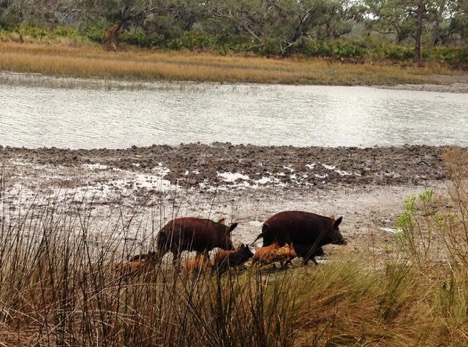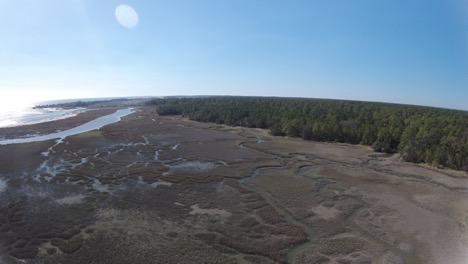Booming feral hog population threatens American salt marshes
Invasive pigs chow down on mussels, threatening marshes’ resilience to drought
Delaney Dryfoos • January 19, 2022

A family of feral hogs scampers on the edge of a salt marsh in coastal Georgia where they trample cordgrass in pursuit of ribbed mussels. This destruction releases tons of carbon into the atmosphere. [Credit: Jennifer Hilburn]
When Marc Hensel was a master’s student in zoology at the University of Florida, he spent a lot of time checking cages filled with cordgrass on Sapelo Island, a barrier island off the coast of Georgia. One day, he found that the cages, which were designed to keep snails from snacking on the grass, had been trampled.
He was stumped as to what animal might be large enough to damage the cages. Then he heard a little pig snort. A family of hogs scampered away, and he followed them with his biologist’s intuition until he came across a valuable deposit they had left behind.
“I saw that they had pooped in the marsh and like any good field biologist, I grabbed a stick and I started to sift through the poop and it was just chock full of mussel shells,” he says.
The mussel shells surprised both Hensel and his advisor, Brian Silliman. Neither was aware that feral hogs had made a home on Sapelo Island or that they were capable of eating mussels whole.
U.S. salt marshes — ecosystems that protect the coast against flooding and erosion and that store large amounts of carbon — are being threatened by invasive feral hogs, Hensel, Silliman and other researchers are finding. These traipsing wild pigs not only trample plants and uproot soil, which leads to the release of massive amounts of stored carbon, but they also chow down on mussels attached to cordgrass.
Smooth cordgrass is an important species in Southeastern U.S. salt marshes. The plant has a large effect on the health of the rest of the marine ecosystem. The attached mussels play a key protective role in defending the salt marshes against intensifying drought.
As these droughts intensify, the number of feral hogs in the U.S. is also increasing. The population of invasive wild pigs in the U.S. has nearly tripled from 1982 to 2016, according to a survey by the Southeastern Cooperative Wildlife Disease Study. The U.S. Department of Agriculture (USDA) estimates their population at over 6 million individuals as of 2019 across at least 35 states, with the largest concentration ranging from Virginia to Texas. Feral hogs have been a fixation of the American landscape since the 1500s when they were brought by early explorers and settlers as a source of food.
Salt marshes in the Southeast have faced massive die-offs due to drought over the past three decades, according to prior research by Silliman. In the last year, dry conditions have intensified across the Southeast. Below-normal precipitation and declining soil moisture have brought increasing drought to the Carolinas and Georgia, according to the U.S. Drought Monitor.
If the region’s salt marshes continue to decline or even die off completely, inland areas are likely to suffer extensive flooding and erosion, which could cause destruction of nearby homes, businesses and farms. It would also remove an important “sponge” that keeps excess groundwater from pulling nutrient-filled topsoil and other possible pollutants out to sea, according to Hensel.
Now a postdoctoral research associate at the Virginia Institute of Marine Science, Hensel has continued to follow the pigs to better understand how their appetite for mussels has affected the health of salt marshes. His latest findings reveal that the invasive hogs’ dining habits indeed are wreaking havoc on the marshes’ resilience to and ability to recover from drought. The results were published last November in Nature Communications.
Ribbed mussels and cordgrass are an example of keystone mutualism, or a relationship that allows both species to survive better and serves as an important protective factor for the ecosystem. Mussels cluster in mounds that facilitate cordgrass growth by enhancing water storage and reducing imbalances in the soil chemistry. This relationship not only helps the grass grow but also recover from drought conditions, Silliman says.
“It’s like a little spa in the marsh,” says Silliman, a marine conservation biologist at the Duke University Nicholas School of the Environment. “All the water percolates through [the mussel mound] so [the cordgrass] gets a great flow of water that brings them oxygen and keeps the salinity lower. So, everything’s better on a mussel mound.”
The mussels act like a magnet that keeps hogs returning to the same disturbed areas of the marsh, trampling cordgrass on their way to a mussel feast. “Once you have hogs in the marsh, the mussels switch from being this huge benefit to a liability,” says Silliman.
Salt marshes are one of the most resilient types of coastal ecosystem, Hensel says. The resilience of marsh ecosystems is only becoming more important as droughts intensify and coasts face increasing threats from climate change.
Salt marshes are also an important carbon sink. By trampling cordgrass, hogs reduce the ability of the plant roots to sequester carbon. These disturbances can cause salt marshes to transition from natural reservoirs for carbon to sources of carbon release.
And these are no trivial quantities. According to a paper published in Global Change Biology, feral hogs are estimated to disturb enough soil worldwide to emit 4.9 million metric tons of carbon dioxide per year, which is equivalent to the emissions released by 1.1 million cars.

The paths of trampled cordgrass that hogs leave in Kenan Marsh on Sapelo Island, Georgia are highly visible when viewed from a high-flying drone. [Credit: Marc Hensel]
On the Georgia barrier islands, hog management has become a full-time job. Each island has one or two professional hunters who shoot pigs from the ground, according to Silliman. Shooting is commonly practiced to control small populations of feral swine. However, shooting a few individuals from a large group could cause them to disperse further and wreak more damage to their environment, according to the USDA, so a variety of control techniques is recommended.
“These hogs are really smart animals,” says Silliman. He adds that some managers also use traps, but the pigs quickly learn how to avoid them. When the hogs smell a path that has been traversed by humans, they will avoid the area for months.
“The feral hog problem is definitely on the minds of every coastal habitat manager that’s out there,” Hensel says. “It’s pretty well accepted that trying to manage feral hog populations is way more about controlling the numbers than completely eradicating.”
This population control will become increasingly important as the established population of wild swine continues to grow across the American Southeast, threatening these resilient and protective ecosystems along the region’s shore.
6 Comments
Need to make it easier and more affordable to hunt them.nonresidents have astronomical fees.
I know they are a big problem. That why we trap shoot and use dogs. A three way approach. I mostly trap with box and circle types. And take out 700 to a 1000 a year in the north east central part of the state. Wilkes county and surrounding county’s. To do what I do you have to incorporate home owners and land owners to take part. And the way I do that is supply traps for them to put eye’s on daily and notify me of a tripped trap to recover pigs and reset the traps.
Free hog hunts are a myth. If they were free, lots of hunters would help out. Mandatory processing fees and the like make it like buying a car and then adding those little extras. End up costing more than going. To the store.. Unless you’re hunting wild Russian boar, this extermination is for an invasive species, not true hunting .
Why did we fail to mention the absence of natural predators and human encroachment as part of the problem? The lack of birds of prey, coyotes and other tertiary predators allows these to overpopulate. The encroachment of humans into all of the alternative habitats inland forces them to the fringes which are these wetlands where it’s difficult to sell real estate.
Farmers lease hunt rights to clubs. I can’t come from va. To hunt. I would any info on places to hunt.
Even here in the semi arid region of central Texas we have hogs infiltrating and overrunning the area. The soil from my hillside has been massively disturbed and the rain has washed it down into the creek bed. I don’t think we can get a handle on these pests unless we take drastic and unpopular measures.